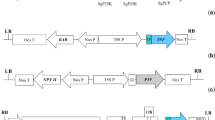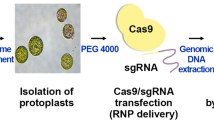Abstract
Two polyubiquitin genes, bul409 and bul427, were isolated from a Solanum bulbocastanum BAC library. The bul409 and bul427 genes encode hexameric and heptameric polyproteins, respectively. bul427 exhibits a number of features suggestive of a pseudogene: (1) The last ubiquitin monomer of bul427 is interrupted by a frame shift mutation. (2) The coding sequence is flanked 3′ by mitochondrial and chloroplast sequences and 5′ by a protein kinase pseudogene. However, characterization of cDNAs amplified using bul427-based primers demonstrated that bul427 is transcriptionally active. Chimeric transgenes encoding β-glucuronidase (GUS) translationally fused to the first ubiquitin-coding units of bul409, a truncated version 409s, and bul427 were constructed and introduced into potato. In transgenic potato lines both S. bulbocastanum promoters were weakly transcribed in tubers and efficiently transcribed in leaves. In leaves, bul409s was wound-induced, while bul427 was not. In tubers both promoters were wound-induced. In unwounded leaves and tubers, the steady state mRNA levels from both bul promoters were lower than the steady state mRNA levels from the Cauliflower Mosaic Virus 35S promoter. However, in the leaves and tubers of many of the transgenic lines the GUS activity was significantly higher in the bul lines compared to the 35S lines. The apparent inconsistency of higher enzymatic activity correlated with lower steady state levels of mRNA demonstrates the enhanced protein expression observed with ubiquitin fusion proteins.
Resumen
Dos genes de poliubiquitina, bul409 y bul427, fueron aislados de una librería BAC de Solanum bulbocastanum. Los genes bul409 y bul427 codifican poliproteínas hexámera y heptámera, respectivamente. El bul427 exhibe varios rasgos que sugieren un seudo gen: (1) El último monómero de bul427 es interrumpido por una mutación con desplazamiento de la pauta de lectura. (2) La secuencia codificante es flanqueada en 3′ por secuencias mitocondriales y de cloroplastos y en 5′ por un seudogen de proteína quinasa. Sin embargo, la caracterización de cDNAs amplificadas usando iniciadores basados en bul427 demostró que bul427 es transcripcionalmente activo. Se construyeron e introdujeron en papa transgenes quiméricos que codifican β-glucuronidasa (GUS) translacionalmente fusionados a las primeras unidades que codifican ubiquitina de bul409, una versión truncada de 409s y bul427. En las líneas de papa transgénica de S. bulbocastanum, los promotores fueron débilmente transcritos en los tubérculos y eficientemente transcritos en hojas. En hojas el bul409s fue inducido por heridas, mientras que bul427 no fue. En tubérculos, ambos promotores fueron inducidos por heridas. En hojas y tubérculos sin herir, los niveles mRNA en estado de equilibrio para ambos promotores bul fueron más bajos que los niveles de mRNA en estado de equilibrio del promotor 35S del virus del Mosaico de la Coliflor. Sin embargo, en hojas y tubérculos de muchas líneas transgénicas, la actividad de GUS fue significativamente más alta en las líneas bul en comparación con las 35S. La aparente inconsistencia de una actividad enzimática mayor, correlacionada con bajos niveles de mRNA en estado de equilibrio demuestra el incremento de la expresión de proteína observada con proteínas fusión ubiquitina.







Similar content being viewed by others
Abbreviations
- GUS:
-
E. coli β-glucuronidase
- BAC:
-
bacterial artificial chromosome
- UTR:
-
untranslated region
References
Akeley, R.V., W.R. Mills, C.E. Cunningham, and J. Watts. 1968. Lenape: a new potato variety high in solids and chipping quality. American Potato Journal 45: 142–151.
Altschul, S.F., W. Gish, W. Miller, E.W. Myers, and D.J. Lipman. 1990. Basic local alignment search tool. Journal of Molecular Biology 215: 403–410.
Atkinson, H.J., S. Grimwood, K. Johnston, and J. Green. 2004. Prototype demonstration of transgenic resistance to the nematode Radopholus similis conferred on banana by a cystatin. Transgenic Research 13: 135–142.
Balakirev, E.S., and F.J. Ayala. 2003. Pseudogenes: are they “junk” or functional DNA? Annual Review of Genetics 37: 123–151.
Binet, M.N., A. Steinmetz, and L.H. Tessier. 1989. The primary structure of sunflower (Helianthus annuus) ubiquitin. Nucleic Acids Research 17: 2119.
Binet, M.N., J.H. Weil, and L.H. Tessier. 1991. Structure and expression of sunflower ubiquitin genes. Plant Molecular Biology 17: 395–407.
Burke, T.J., J. Callis, and R.D. Vierstra. 1988. Characterization of a polyubiquitin gene from Arabidopsis thaliana. Molecular Gen Genetics 213: 435–443.
Chen, T.L., Y.L. Lin, Y.L. Lee, N.S. Yang, and M.T. Chan. 2004. Expression of bioactive human interferon-gamma in transgenic rice cell suspension cultures. Transgenic Research 13: 499–510.
Christensen, A.H., and P.H. Quail. 1996. Ubiquitin promoter-based vectors for high-level expression of selectable and/or screenable marker genes in monocotyledonous plants. Transgenic Research 5: 213–218.
Fujino, K., H. Sekiguchi, and T. Kiguchi. 2005. Identification of an active transposon in intact rice plants. Molecular Genetics & Genomics 273: 150–157.
Garbarino, J.E., and W.R. Belknap. 1994. Isolation of a ubiquitin-ribosomal protein gene (ubi3) from potato and expression of its promoter in transgenic plants. Plant Molecular Biology 24: 119–127.
Garbarino, J.E., D.R. Rockhold, and W.R. Belknap. 1992. Expression of stress-responsive ubiquitin genes in potato tubers. Plant Molecular Biology 20: 235–244.
Garbarino, J.E., T. Oosumi, and W.R. Belknap. 1995. Isolation of a polyubiquitin promoter and its expression in transgenic potato plants. Plant Physiology 109: 1371–1378.
Hondred, D., J.M. Walker, D.E. Mathews, and R.D. Vierstra. 1999. Use of ubiquitin fusions to augment protein expression in transgenic plants. Plant Physiology 119: 713–724.
Jefferson, R.A., S.M. Burgess, and D. Hirsh. 1986. b-Glucuronidase from Escherichia coli as a gene-fusion marker. Proceedings of the National Academy of Sciences of the United States of America 83: 8447–8451.
Jefferson, R.A., T.A. Kavanagh, and M.W. Bevan. 1987. GUS Fusions: beta-glucuronidase as a sensitive and versatile gene fusion marker in higher plants. EMBO Journal 6: 3901–3907.
Joung, Y.H., and K. Kamo. 2006. Expression of a polyubiquitin promoter isolated from Gladiolus. Plant Cell Reports 25: 1081–1088.
Kang, T.J., B.G. Kim, J.Y. Yang, and M.S. Yang. 2006. Expression of a synthetic cholera toxin B subunit in tobacco using ubiquitin promoter and bar gene as a selectable marker. Molecular Biotechnology 32: 93–100.
Kay, R., A. Chan, M. Daly, and J. McPherson. 1987. Duplication of CaMV 35S promoter sequences creates a strong enhancer for plant genes. Science 236: 1299–1302.
McCue, K.F., P.V. Allen, L.V. Shepherd, A. Blake, J. Whitworth, M.M. Maccree, D.R. Rockhold, D. Stewart, H.V. Davies, and W.R. Belknap. 2006. The primary in vivo steroidal alkaloid glucosyltransferase from potato. Phytochemistry 67: 1590–1597.
Ozkaynak, E., D. Finley, M.J. Solomon, and A. Varshavsky. 1987. The yeast ubiquitin genes: a family of natural gene fusions. EMBO Journal 6: 1429–1439.
Panahi, M., Z. Alli, X. Cheng, L. Belbaraka, J. Belgoudi, R. Sardana, J. Phipps, and I. Altosaar. 2004. Recombinant protein expression plasmids optimized for industrial E. coli fermentation and plant systems produce biologically active human insulin-like growth factor-1 in transgenic rice and tobacco plants. Transgenic Research 13: 245–259.
Plesse, B., M.C. Criqui, A. Durr, Y. Parmentier, J. Fleck, and P. Genschik. 2001. Effects of the polyubiquitin gene Ubi. U4 leader intron and first ubiquitin monomer on reporter gene expression in Nicotiana tabacum. Plant Molecular Biology 45: 655–667.
Pustell, J., and F.C. Kafatos. 1982. A high speed, high capacity homology matrix: zooming through SV40 and polyoma. Nucleic Acids Research 10: 4765–4782.
Ramesh, S.A., S. Choimes, and D.P. Schachtman. 2004. Over-expression of an Arabidopsis zinc transporter in Hordeum vulgare increases short-term zinc uptake after zinc deprivation and seed zinc content. Plant Molecular Biology 54: 373–385.
Rollfinke, I.K., M.V. Silber, and U.M. Pfitzner. 1998. Characterization and expression of a heptaubiquitin gene from tomato. Gene 211: 267–276.
Rommens, C.M., J.M. Humara, J. Ye, H. Yan, C. Richael, L. Zhang, R. Perry, and K. Swords. 2004. Crop improvement through modification of the plant’s own genome. Plant Physiology 135: 421–431.
Schultheiss, H., G. Hensel, J. Imani, S. Broeders, U. Sonnewald, K.H. Kogel, J. Kumlehn, and R. Huckelhoven. 2005. Ectopic expression of constitutively activated RACB in barley enhances susceptibility to powdery mildew and abiotic stress. Plant Physiology 139: 353–362.
Sivamani, E., and R. Qu. 2006. Expression enhancement of a rice polyubiquitin gene promoter. Plant Molecular Biology 60: 225–239.
Smalle, J., and R.D. Vierstra. 2004. The ubiquitin 26S proteasome proteolytic pathway. Annual Review of Plant Biology 55: 555–590.
Snyder, G.W., and W.R. Belknap. 1993. A modified method for routine Agrobacterium-mediated transformation of in vitro grown potato microtubers. Plant Cell Reports 12: 324–327.
Song, J., F. Dong, and J. Jiang. 2000. Construction of a bacterial artificial chromosome (BAC) library for potato molecular cytogenetics research. Genome 43: 199–204.
Tiimonen, H., T. Aronen, T. Laakso, P. Saranpaa, V. Chiang, T. Ylioja, H. Roininen, and H. Haggman. 2005. Does lignin modification affect feeding preference or growth performance of insect herbivores in transgenic silver birch (Betula pendula Roth)? Planta 222: 699–708.
Verwoerd, T.C., B.M.M. Dekker, and A. Hoekema. 1989. A small-scale procedure for the rapid isolation of plant RNAs. Nucleic Acids Research 17: 2362.
Wang, J., J. Jiang, and J.H. Oard. 2000. Structure, expression and promoter activity of two polyubiquitin genes from rice (Oryza sativa L.). Plant Science 156: 201–211.
Yang, Z.Q., Q.Q. Liu, Z.M. Pan, H.X. Yu, and X.A. Jiao. 2007. Expression of the fusion glycoprotein of Newcastle disease virus in transgenic rice and its immunogenicity in mice. Vaccine 25: 591–598.
Acknowledgements
The authors acknowledge funding by the Agricultural Research Service National Programs (Project Number 5325-21420-001-00).
Author information
Authors and Affiliations
Corresponding author
Additional information
The mention of a trademark or proprietary product does not constitute a guarantee or warranty of the product by the US Department of Agriculture and does not imply its approval to the exclusion of other products that may be suitable.
Rights and permissions
About this article
Cite this article
Rockhold, D.R., Chang, S., Taylor, N. et al. Structure of Two Solanum bulbocastanum Polyubiquitin Genes and Expression of Their Promoters in Transgenic Potatoes. Am. J. Pot Res 85, 219–226 (2008). https://doi.org/10.1007/s12230-008-9015-5
Published:
Issue Date:
DOI: https://doi.org/10.1007/s12230-008-9015-5




